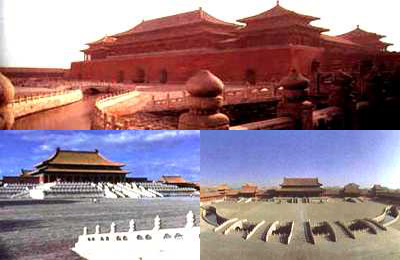 The Meridian Gate
The Meridian Gate
The Meridian Gate as viewed from inside the Forbidden City. Built in 1420, it is 37.95 metres high and is the main gate of the Forbidden City. The bells and drums in the gate tower were sounded to accompany important ceremonies presided over by the emperor.
During important ceremonies presided over by the emperor, guards of honour lined up on the square between the Meridian Gate and the Gate of Supreme Harmony, the largest square in the palace complex
Watch Tower
This is one of the watchtowers on the four corners of the wall surrounding the Forbidden City. Each watchtower is supported by nine beams and 18 Pillars and has three layers of eaves. There are 72 ridges on the roof with a gilded spire in the centre.
Hall of Supreme Harmony
Built from south to north on an eight-metre-high marble foundation, the Hall of Supreme Harmony, the Hall of Medium Harmony and the Hall of Protective Harmony form the Outer Court of the Forbidden City together with the Hall of Literary Glory on their east side and the Hall of Military Prowess on their west side.
The Hall of Supreme Harmony, also referred to as the throne, is 35 metres high, the highest of the halls in the Forbidden City. It was used for important ceremonies like the enthronement of the crown prince, the emperor's birthday celebrations, and the initiation of military expeditions.
This is the square between the Meridian Gate and the Gate of Supreme Harmony, just ahead. Guards of honor would line up in this square (the largest in the palace complex) before important ceremonies.
Hall of Medium Harmony
The Hall of Medium Harmony is where the emperors rested before major ceremonies or receiving officials.
Hall of Protective Harmony
The Hall of Protective Harmony is where the emperors gave banquets and interviewed those who had successfully passed the gruelling imperial examinations. This is the emperor's throne.
Hall of Celestial Purity
The front chamber of the Palace of Heavenly Purity, where the emperor attended to state affairs almost everyday.
Hall of Celestial Purity
The front chamber of the Palace of Heavenly Purity, where the emperor attended to state affairs almost everyday.
Hall of Earthly Peace
The Hall of Earthly Peace was the residence of the empress and contained her bed chamber The picture shows the east side chamber of the hall, which served as the bridal chamber for the emperor and empress during their wedding. As a rule, they stayed here only for three days before returning to their respective residences.
The Imperial Garden
This would be the emperor's view upon entering the Imperial Garden, built in 1417. The large urn ahead is an incense burner.
One of the eight pavillions in the middle of the garden.
Every year, on the ninth day of the ninth lunar month, the Emperor and Empress would climb the hill to view the distant scenery.
The north gate of the Imperial Garden viewed at dusk. It leads to the Gate of Divine Might, the rear gate of the Forbidden City.
|

